Making America’s rivers blue again: Connecting the dots between regenerative agriculture and healthy waterways

Published: April 8, 2021
Category: Regenerative Agriculture
By John Roulac
Two hundred years ago, before the Industrial Revolution, the rivers across North America ran clear and blue. Rivers from the mighty Mississippi to the Columbia flowed wild and clean into the sea.
In the 1800s and 1900s, the growth of manufacturing and agriculture across the continent brought prosperity to America, but at the great cost of unmitigated pollution. In 1969, Ohio’s Cuyahoga River caught fire due to toxic runoff from nearby factories.
The food industry is complex and, like all established industries, focused on staying profitable. Today’s agricultural practices result in rainstorms washing pesticides, fertilizers, feedlot manure, and bare soil into our waterways and oceans, turning rivers from clear reflections of blue skies to hues of greenish brown.
The good news: there are profitable and earth-friendly ways to grow nutrient-dense food, draw down carbon to address climate chaos. Soil regeneration is the solution.
“Regenerative Agriculture” describes farming and grazing practices that reverse climate change by rebuilding soil organic matter and restoring degraded soil biodiversity—resulting in both carbon drawdown and an improved water cycle. There are five recognized principles of regenerative agriculture: keep the soil covered, minimize soil disturbance, maximize crop diversity, maintain living roots in the ground year-round, and integrate livestock.
Discoloring Our Rivers
Satellite images show that many of America’s rivers have changed color since 1984. The massive change comes from modern farming practices, so reliant on tilling, pesticides, chemical fertilizers, and bare, fallow farmlands. Companies like Monsanto, Bayer, Dupont, and Syngenta (pesticides and genetics); Tyson, Smithfield, ADM, Bunge, and Cargill (processors); and General Mills, Danone, Nestle, Mars, Heinz, and Hormel (food brands)—hereinafter referred to as “Big Ag”—have built an agriculture system based on synthetic chemicals.
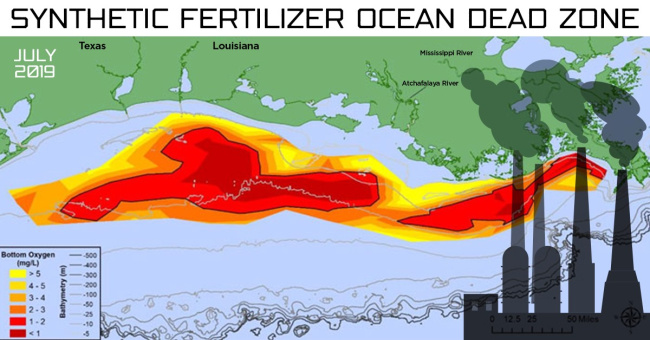
The synthetic fertilizers used by most U.S. farmers inevitably run off into waterways, color our rivers green with deadly algae blooms, and kill aquatic life (called eutrophication). For instance, the southern U.S. runoff zone, the Gulf of Mexico, is now a “dead zone”— measuring 6,952 square miles in 2019.
It’s important to understand that fertilizer is predominantly made from fracked natural gas, releasing nitrous oxide (N2O)—a greenhouse gas 300 times more potent than carbon dioxide, but virtually ignored in climate change discussions. In a recent study published in the journal Nature, an international team of scientists discovered that N2O emissions are increasing at a faster rate than any other type of greenhouse gas emission, mainly due to a rise in nitrogen fertilizer application for food production.
The real issue is nitrous oxide belching from fertilizer plants not from cows munching grass. Monsanto, the fertilizer industry, and Impossible Foods is betting they can pull a fast one on Americans.
America’s consumption of CAFO chicken is growing, with more than nine billion broilers produced for KFC, Chick-fil-A, and retailers such as Costco each year. Rural America is a sacrifice zone, dealing with impacts to both air and water. Over 20% of rural wells in ag regions are contaminated from synthetic fertilizers.
Farmers who practice regenerative agriculture can reduce their chemical inputs, saving millions of dollars while building healthy, spongy soil with an increased water-holding capacity. Such practices will keep our streams, rivers, lakes, and gulfs flowing with clear, fresh blue water.
Got GMOs?
It’s not just our waterways that are being harmed. A shocking new study published in the Proceedings of the National Academies of Sciences notes that insect populations are dropping 1–2% per year and “. . . are absolutely the fabric by which Mother Nature and the tree of life are built.” Scientists believe pesticides are a leading cause of this collapse. Some critics of regenerative agriculture focus on carbon and miss other linkages.
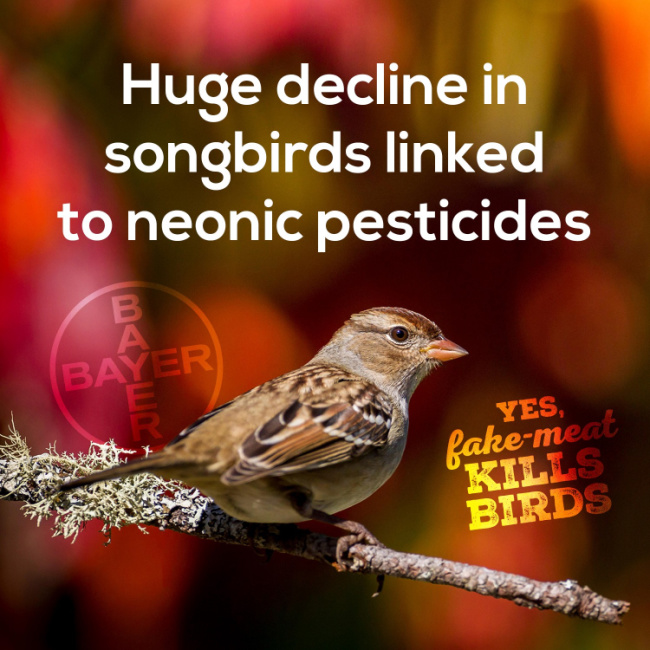
The Myths of Fake Meat
“The mad rush for fake food and fake meat,” writes Dr. Vandana Shiva, “is a recipe for accelerating the destruction of the planet and our health.”
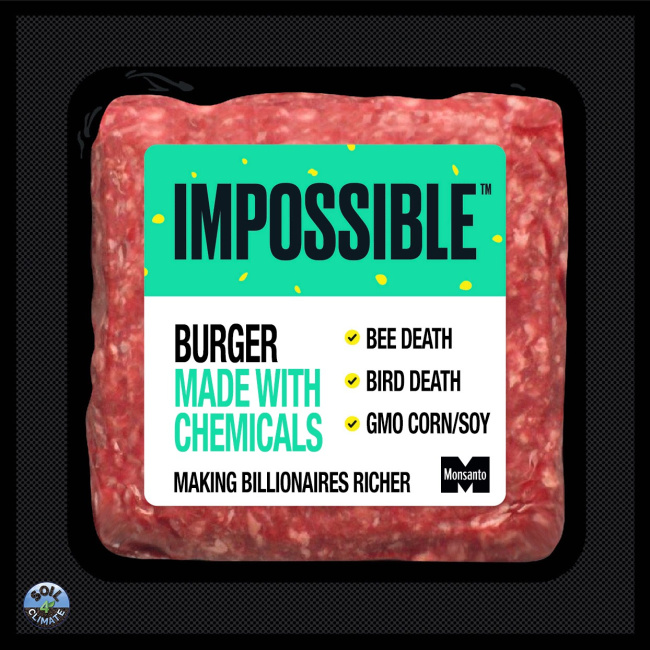
The modus operandi of the CAFO giants (Tyson, Hormel, Smithfield, et al) is to continue producing ecologically devastating factory-farmed feedlot beef, chicken, and pork while simultaneously introducing patented and highly processed fake-meat foods. Plant-based meat alternatives are a superb way of distracting health-and-animal-rights-oriented consumers from Big Ag’s overreliance on tillage, monocrops, GMOs, and toxic pesticides. Many Americans now shy away from GMO foods, switching to certified Non-GMO, pasture-finished, and organic foods.
“Most people don’t understand the earth’s water and carbon cycles, and this results in destruction of our natural resources.”
What is a dominant industry to do? Fear not, Big Ag has a plan: combine its GMO and other crops into novel products that approximate meat, rebrand them as “plant-based,” et voilà!
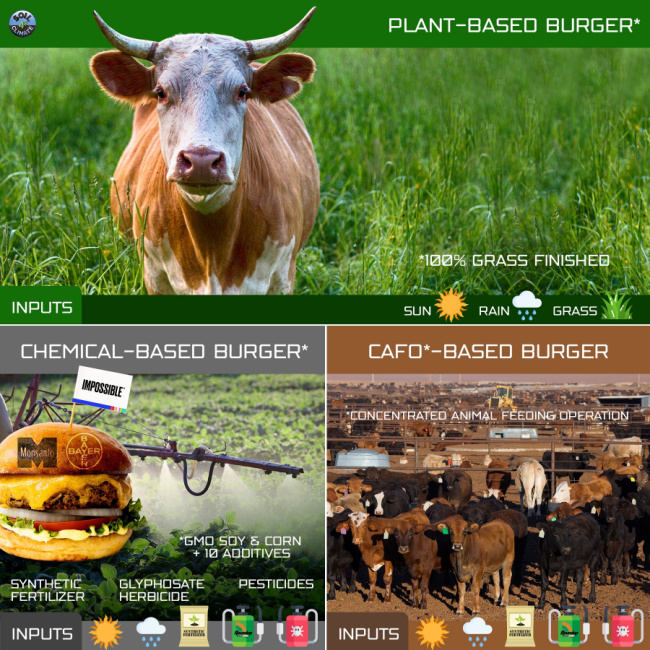
Missing the Mark
Big Ag has rebranded “plant-based” and partnered with a high-powered “greenwash orchestra” to sing the praises of bird-killing meat alternatives. How vegan is that? A powerful alliance of Wall Street and Silicon Valley investors, Big Ag executives, and the billionaire-backed plant-based food industry, with their well-paid allies from Oxford University and The Guardian, form the choir. Most of these “experts” lack scientific curiosity, undervalue the promise of regenerative agriculture, and thus are missing the mark of regen ag.
Hoofed animals are essential to restoring the earth’s vast grasslands through holistic grazing, with a huge upside for carbon sequestration achieved where farm crops cannot grow.
In holistic regenerative systems, animals graze the grass and do not return until the grass is knee-high. While it seems counterintuitive, over time more animals—not less— will be needed as the grassland regenerates.
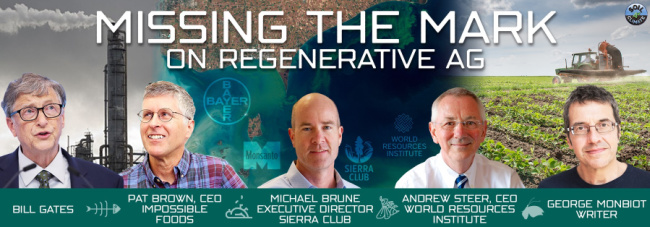
Leaders who are “missing the mark” and thus helping to pollute America’s rivers include:
1. Bill Gates, a major investor in fake-meat companies (such as his $50M investment in Impossible Foods), is also a major funder of chemical GMO agriculture. While his foundation has done other good work (along with Gates recent focus on greening the cement and steel sectors), his investments in Monsanto represents a double standard.
Gates is now the top private farmland owner in America, and his alliance with Bayer/Monsanto jeopardizes vast amounts of American farmland. In 2006, the Bill & Melinda Gates and Rockefeller Foundations launched the nearly $1B Alliance for a Green Revolution in Africa (AGRA). This resulted in significant failure that ignored regional food solutions while pushing high-tech fertilizers, pesticides, and hybrid seeds.
2. Impossible Foods CEO Pat Brown, who has declared that he wants to end all animal agriculture by 2035.
Supporting Cast:
3. The Sierra Club, which has attacked regenerative ag while promoting the Impossible Burger (made with Bayer/Monsanto’s bee-killing GMO soy and corn) via tweets and videos. It is encouraging to see several Sierra Club ag state chapters prioritize soil health. For example, the Iowa chapter has an excellent farm policy that acknowledges the role of animals in soil health. However, to date the national headquarters has chosen to ignore the Midwest chapters. The Club has received over $140M from Michael Bloomberg.
4. World Resource Institute (WRI) has published reports dismissing the potential of regenerative agriculture while undervaluing the role of holistic grazing and healthy soil biology. Six leading researchers from the U.S., France, and Scotland recently disputed a WRI report, stating, “The science is clear that regenerative agricultural practices have the biophysical capability to contribute significantly to both soil health and climate change mitigation!”
A web data search of WRI’s food reports yields no results for Monsanto or Bayer. How can this NGO address global environmental and food issues with no mention of the world’s largest pesticide and GMO seed companies? And, in 2008, a WRI blog post said of Monsanto’s cancer-linked glyphosate: “The weed killer is generally considered safe for workers.”
Further, the WRI July 2019 Sustainable Food Report/Course 5, “Reduce Greenhouse Gas Emissions from Agriculture Production,” listed four key approaches yet overlooked regen ag as a key driver to reduce nitrogen demand. From America to Africa, regen farmers and ranchers (far from WRI’s DC and London offices) are proving that food can be grown without copious amounts of nitrogen fertilizers.
WRI influences UN food policies and attracts big money; Jeff Bezos recently donated $100M. Like the Sierra Club, WRI does good work in forestry, yet its food-policy research leaves much to be desired.
5. British writer and animal rights activist George Monbiot pushes a plant-based view while dismissing non-vegan regenerative agriculture. Monbiot mistakenly views grazing animals as the enemy to be removed.
In 2015 EcoWatch published my letter “Why Are Climate Groups Only Focused on 50% of the Solution?” describing how soil health regeneration could address climate chaos. Paul Hawken’s Project Drawdown shows that many of the leading climate solutions are nature-based (soils, forestry, agroforestry, holistic grazing, etc.). While many national environmental groups have kept their heads buried in the sand, the Natural Resources Defense Council (NRDC) is actively promoting the importance of soil health. And I applaud the National Audubon Society’s 2019 article, “Grazing Like It’s 1799: How Ranchers Can Bring Back Grassland Birds.” A new ranching generation is taking cues from historical bison herds to help prairies and wildlife.
“Each 1% increase in soil organic matter helps hold another 20,000 gallons of water per acre, making the land more resistant to droughts and floods.”
The challenge: Most people don’t understand the earth’s water and carbon cycles, and this results in destruction of our natural resources.
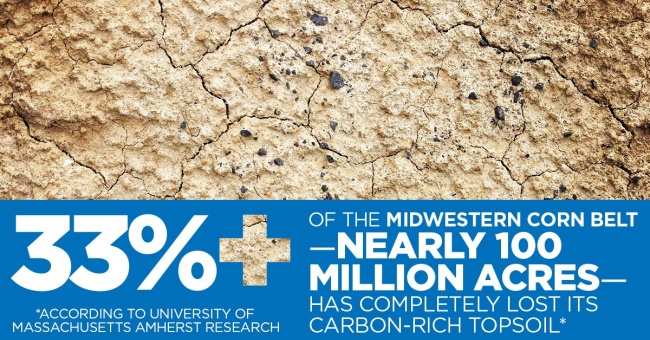
Soil Regeneration Is the Answer
Regenerative agriculture is a renewal of hearts and minds that transforms farming and ranching. It is a conscientious agricultural system that mimics nature’s patterns and prioritizes the health of the soil. Regenerative farmers use cover crops (keeping soil covered year-round), agroforestry, and holistic animal grazing. Large-scale farmers like Rick Clark of Indiana, who successfully manages a 7,000 acre, no-till organic regenerative farming operation.
Here are five useful measurement tools for quantifying regenerative agriculture.
Each 1% increase in soil organic matter helps hold another 20,000 gallons of water per acre, making the land more resistant to droughts and floods. And this helps restore the water cycle, which many believe may be even more important than the carbon cycle to moderate climate chaos.
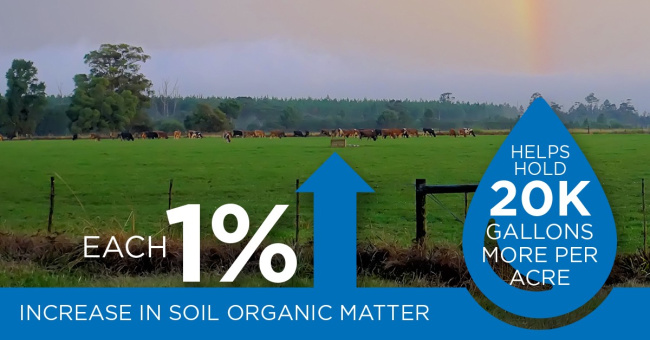
The Netflix film blockbuster Kiss the Ground (of which I’m an Executive Producer) shows us what the future is made of: a dynamic and growing movement of farmers, ranchers, investors, and food advocates creating a new dawn for agriculture.
In Guatemala, Contour Lines Corp. is replacing “slash-and-burn” ag with organic food forests to empower dozens of indigenous communities. Anthony Myint has founded Zero Food Print, a program for restaurants to add a few cents’ cost to each meal, using funds to create a table-to-farm movement that helps farmers implement regenerative practices.
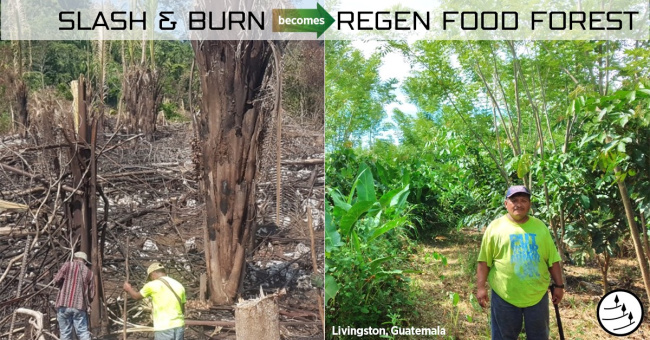
For eons, indigenous peoples have grazed animals for food, fiber, and sustenance. They don’t see themselves as separate from nature. Urban elites who dismiss the need for animals betray their lack of ecological literacy. Worse, their mindset can be seen as colonialist, for many pastoralist communities around the world still depend on livestock for their livelihoods.
Sadly, Western history and policies have discriminated against people of color. Yet a growing movement exists to change federal policies to allow loans and land access to Black and Native American farmers and ranchers. One such project is the Rosebud Economic Development Corporation (REDCO), including the Rosebud Sioux Tribe’s plan to build a 1,500-head bison herd on 28,000 acres of tribal land by 2025, with support from the U.S. Department of the Interior and World Wildlife Fund.
Personal Health Begins in the Soil
Today’s degenerate food system (factory meat or plant-based) is fueled by Omega-6-laden corn, soy, and canola oil, which are leading contributors to heart disease and inflammation. A CAFO burger has up to four times more Omega-6 and five times less Vitamin E than a 100% pasture-raised burger. Persistent pesticide use leads to human and animal gut-health issues. Regenerative food is more nutrient-dense, and it nurtures our immune system and gut biome.
“Contemporary soil quality is so poor that today’s food contains a mere fraction of the minerals and vitamins it held eighty years ago.”
Let’s build a regenerative food system where bees buzz, dragonflies hover, and fish and frogs thrive. It’s going to take a change of hearts and minds; only then will America’s rivers run blue again. Let’s regenerate.
John Roulac is the founder of Nutiva, an innovative organic food company, and executive producer of Kiss the Ground, a documentary film about the need to regenerate the world’s soils.
Organic & Non-GMO Insights April 2021








